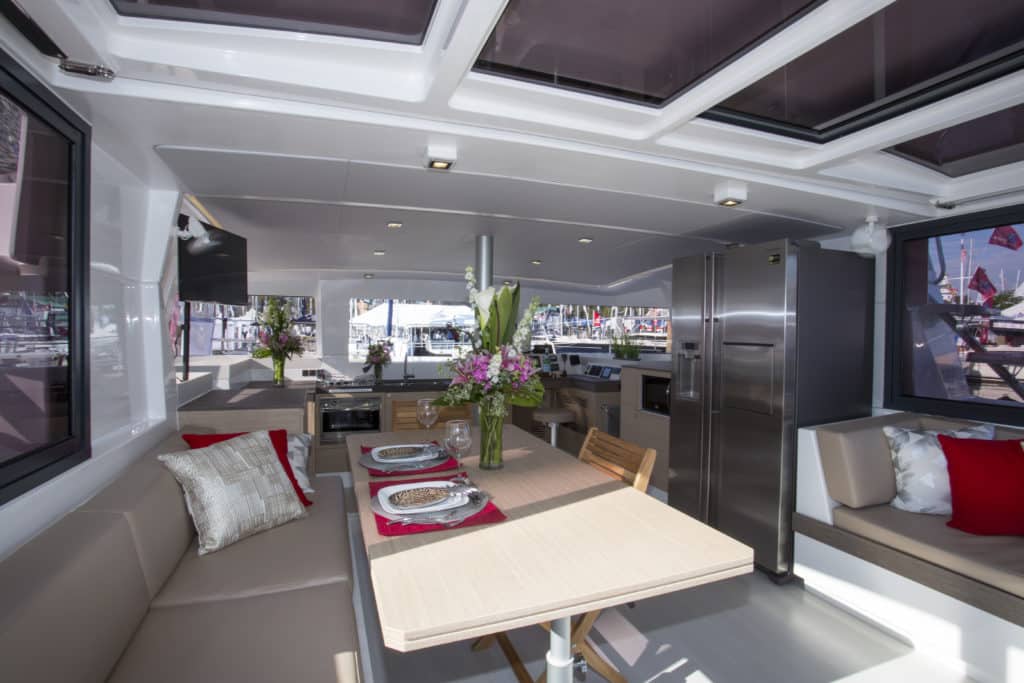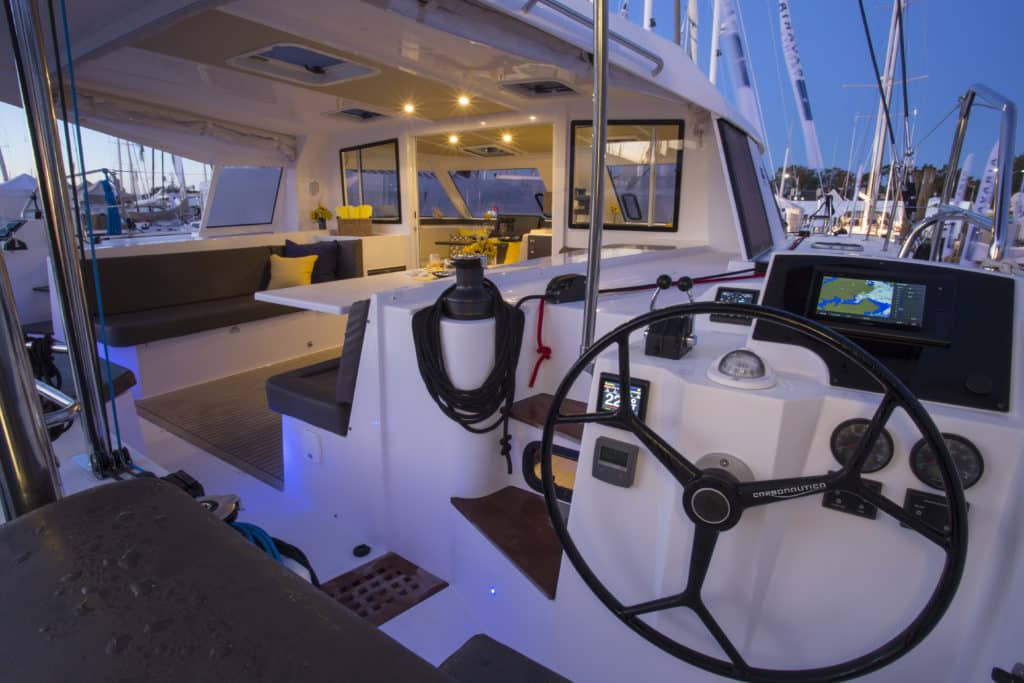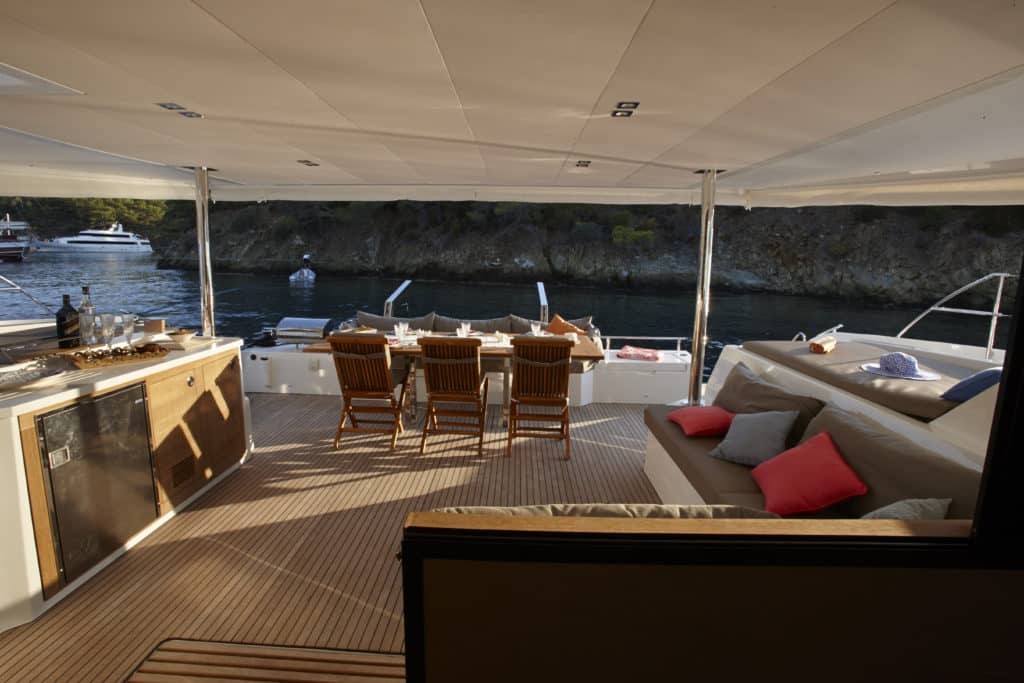
Normally, any article concerning multihulls spends half its ink comparing them to monohulls. Hopefully, in previously tackling this topic, I’ve made my position clear: This sometimes contentious debate over the merits of these different crafts is done and dusted. Catamarans and trimarans are popular and viable cruising platforms that deserve serious discussion and consideration.
At issue now is the rapid development of multihull concepts, designs and construction. While the recent popularity of catamarans may suggest a paradigm shift, multihulls are not immune to the age-old forces of physics. Their performance characteristics are still determined by hull form, windage, weight, sail area-to-displacement ratio and lateral resistance. Thus they come in all shapes and sizes, spanning the spectrum from flying foils to rooftop party platforms.
Yet there were salient themes running through the Best Multihull Cruiser category in Cruising World’s 2016 Boat of the Year contest. The focus seemed to be on enhanced open flow between indoor and outdoor living spaces, more and larger lounging areas, improved visibility, and loads of natural light. The Bali 4.3 took the most radical approach to the indoor/outdoor issue by simply eradicating that delineation. The builders took out the main bulkhead that normally divides and defines those spaces and installed a hull-spanning drop-down door aft. When the door is raised (with the help of an electric motor), the entire boat is transformed into one outdoor area. When the door is down, the space is enclosed from rain, wind and spray. The company calls this configuration the “loft mode,” and not since the Maine Cat series have we seen such unobstructed expanses. This design eliminates the need for two dining tables and connects the galley directly to the main social area.
The traditional forward trampoline has been glassed over and surrounded by cushioned seating with a footwell, replete with twin cocktail tables to create yet another spacious social area. The cabin deadlight forward incorporates a drop-down window that ventilates the entire vessel and connects the forward area to the entire boat.
Because the cabin of the 4.3 is entirely enclosed, the helm had to be elevated to starboard in a flybridge setup. That required lifting the boom for safe clearance, which raises the sail plan’s center of effort substantially while reducing the mainsail area, both detriments to high performance.
Bavaria collaborated with the French cat builder Nautitech, which it now owns, to create the Bavaria Open 40, named the Best Multihull Cruiser for 2016. Designer Marc Lombard has struck a nuanced balance between smooth performance, increased recreational space and open flow.
Addressing the importance of performance, even our high priest of traditionalism, L. Francis Herreshoff, once said, “The fun of sailing is proportional to the speed of sailing.” And even without the daggerboards that usually define high-performance catamarans, plenty of joy will be discovered in the Open 40’s narrow hulls, generous standard sail area (980 square feet) and clever weight-saving gimmicks. For example, instead of running wires from every single light fixture to a switch on the wall and back to the fixture, the Open 40’s switching mechanism has been incorporated into the light itself. It may not sound like much of a savings until one calculates the many hundreds of feet of wire (and, by extension, weight) that’s been eliminated. That attention to weight reduction throughout the boat translates into a lean 7.8 tons of displacement over 40 feet of waterline.
Like the Bali, the Open 40 features a fixed bimini over the length of the cockpit, but with roll-down side flaps. When the main doors (located in a traditional cabin bulkhead) are open, this creates a single large space between the interior saloon and the exterior cockpit. Because the large cockpit table is so well protected, only a small cocktail table is required within. This space doubles as the navigation station, and when the table is dropped down and cushions are inserted, it becomes a perfectly secure playpen for toddlers.
Lombard has tapered the bimini in such a way that twin helms are neatly tucked in at deck level, but well outboard and aft, resulting in outstanding visibility from either steering station. This emphasis on visibility and light is apparent throughout the vessel, as in the wraparound front deadlights with minimal sills to impede the view. Recessed diesel fills and a water catchment system built into the bimini are just two of many clever features found on the 40 that I hope will catch on with other builders.

The Leopard cats, no doubt inspired by the work of designer Chris White, further popularized the forward cockpit theme with a stout door opening from the main saloon directly forward, eliminating the need to go aft and around the coachroof to reach the foredeck. On larger models, the builder created a cockpit-like area with seats and a table. In the Leopard 40, however, this is simply a passage. The Leopard bucks the aforementioned trend in open floor plans; rather than meld living spaces, the builders intentionally broke them up into well-defined areas of privacy, providing the option of sun and breeze forward or shade and protection aft, as well as a choice of indoor or outdoor dining at two substantial tables.
Visually, these areas are all connected by very large deadlights, so there is no sense of confinement. Their interior volume was substantially increased by adding two inches to the hull width, but only from the waterline up, which should not impact performance. Ultimately, however, extra space equates to extra weight, and this approach will reach a point of diminishing returns.
By maintaining an interior saloon dining area and a cockpit dining area offset to port, the Voyage 480 featured the most traditional layout of this year’s entrants. The company kept the relatively small, disc-shaped hardtop and eschewed any physical connection with the foredeck. The boat’s proportions are well balanced, resulting in an attractive vessel . One distinctive feature is the lack of dinghy davits aft. The Voyage instead has two adjustable rubber notches for the keel of the tender to sit in on the aft crossbeam.
At 58 feet in length and with 29 feet of beam, Fountaine Pajot’s Ipanema 58 has no need to be overly clever with space. Instead, the company has seemingly done everything in triplicate. There is a large cockpit area with a table for 10 and separate, commodious cushioned seating. The main saloon sports its own large convertible cocktail/dining table, and on the upper deck lies an enormous area with cocktail tables, high-backed lounge seats, a wet bar, refrigeration and a barbecue area. You can almost hear someone ask, “Sir, madam, would you perhaps like to sit at the bar while your table is being prepared?”
As for lounging spaces on the 58, take your pick — the enormous expanse forward, the voluminous protected cockpit, or a cruise-ship-proportioned sun deck aft of the upper lounge area. All sailing functions lead directly to the central bridgedeck helm, which offers excellent visibility when docking. It is protected from the sun with a notably small bimini and from spray with an equally small splash screen. If it feels a bit open to the elements, remember that, in fairness, the design’s core concept is based on chasing the endless summer, so the upper steering station probably won’t see much use on tempestuous days when the autopilot takes over.
Inherent in all contemporary catamaran designs are sleeping quarters located below the sunny main-deck level, down in the hulls. Following the “let there be light” trend, all of 2016’s multihull nominees created ample interior brightness with multiple deadlights in the hulls and hatches above. Putting the extra cost aside, recessing those hatches at deck level would greatly enhance safe and unimpeded flow forward.

Other noticeable trends? The mainsheet traveler, which in the past was often found running along the aft coaming, has almost universally been moved to the top of the hard bimini. This clears the cockpit and opens the space for recreational use, as seen to good effect in the Open 40, which installed a plush seat and backrest there.
Water toys are integral to the modern cruising lifestyle. All the cats boasted built-in stowage facilities for kayaks, surfboards and paddleboards. The Voyage 480 even had designated stowage lockers for scuba gear. Meanwhile the ease of entrance aft, from the water, was well thought out across the board, with low platforms, drop-down ladders and good handholds.
A tacit assumption that twin rudders are sufficient steering redundancy was found in the minimal attention to emergency steering mechanisms, except on the Open 40, which, despite having the built-in redundancy of twin helms, also provided good access to the rudderheads and space to swing emergency tillers.
With the expansion of social spaces on the foredeck, multihull galleys are being swung around on many designs to a forward-facing orientation. Multiple cabins mean larger crews to feed. Increasingly, those galleys are being equipped with standard-size kitchen appliances.
None of these trends are relevant to those who feel the need to go bashing about the northern ice fields. Rather, they are responses to an unabashedly languid, recreational market with tropical sailing in mind. But I believe that at the core of this movement, there is also an important social component. Quite simply, people want to share these white sand, aqua-blue experiences with family and friends. And modern multihull manufacturers have focused on providing the platforms, amenities and space — both private and communal — to optimize that quest.
*Author and adventurer Alvah Simon, a two-time circumnavigator and CW editor-at-large, served on the judging panel for the 2016 Boat of the Year competition. *








